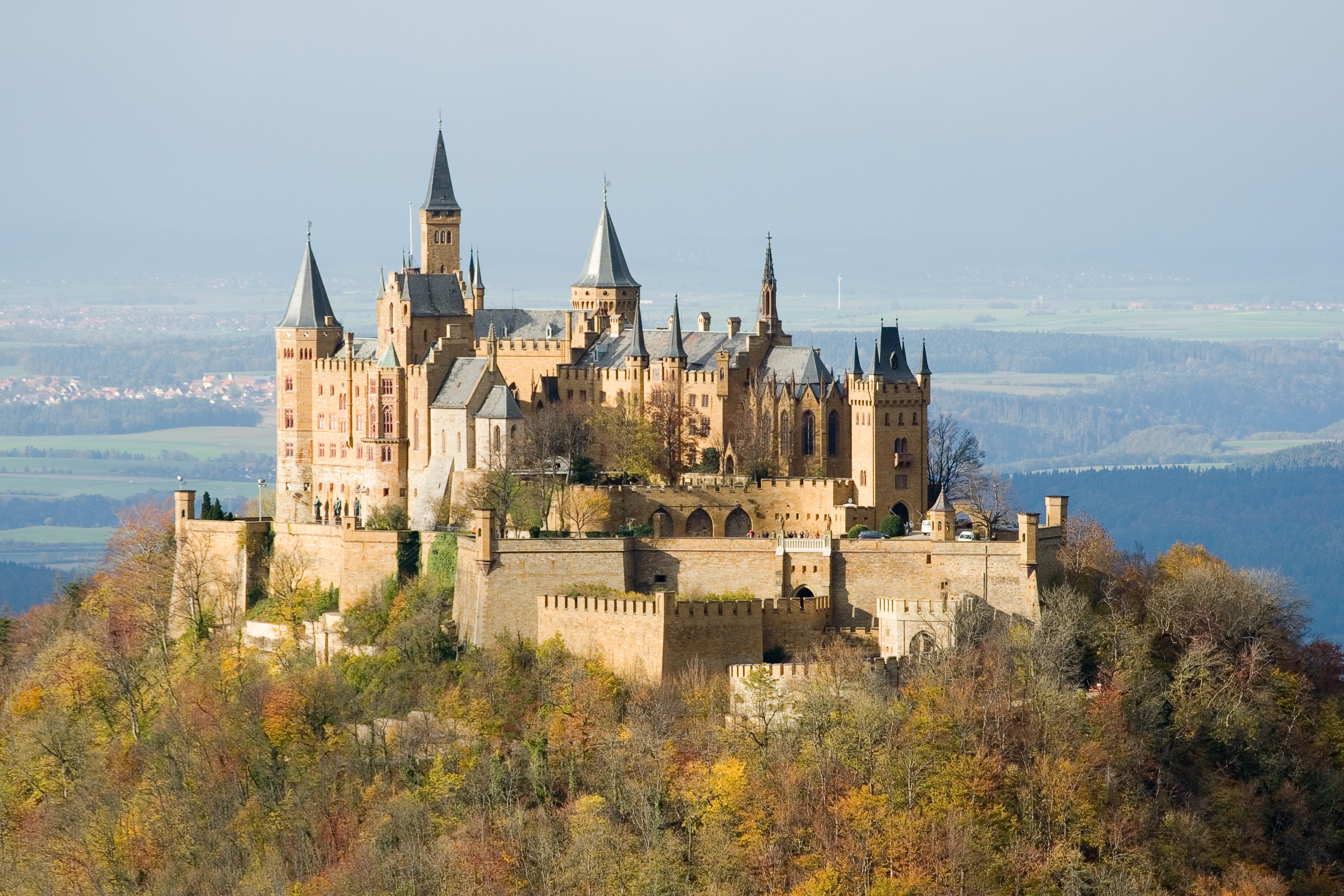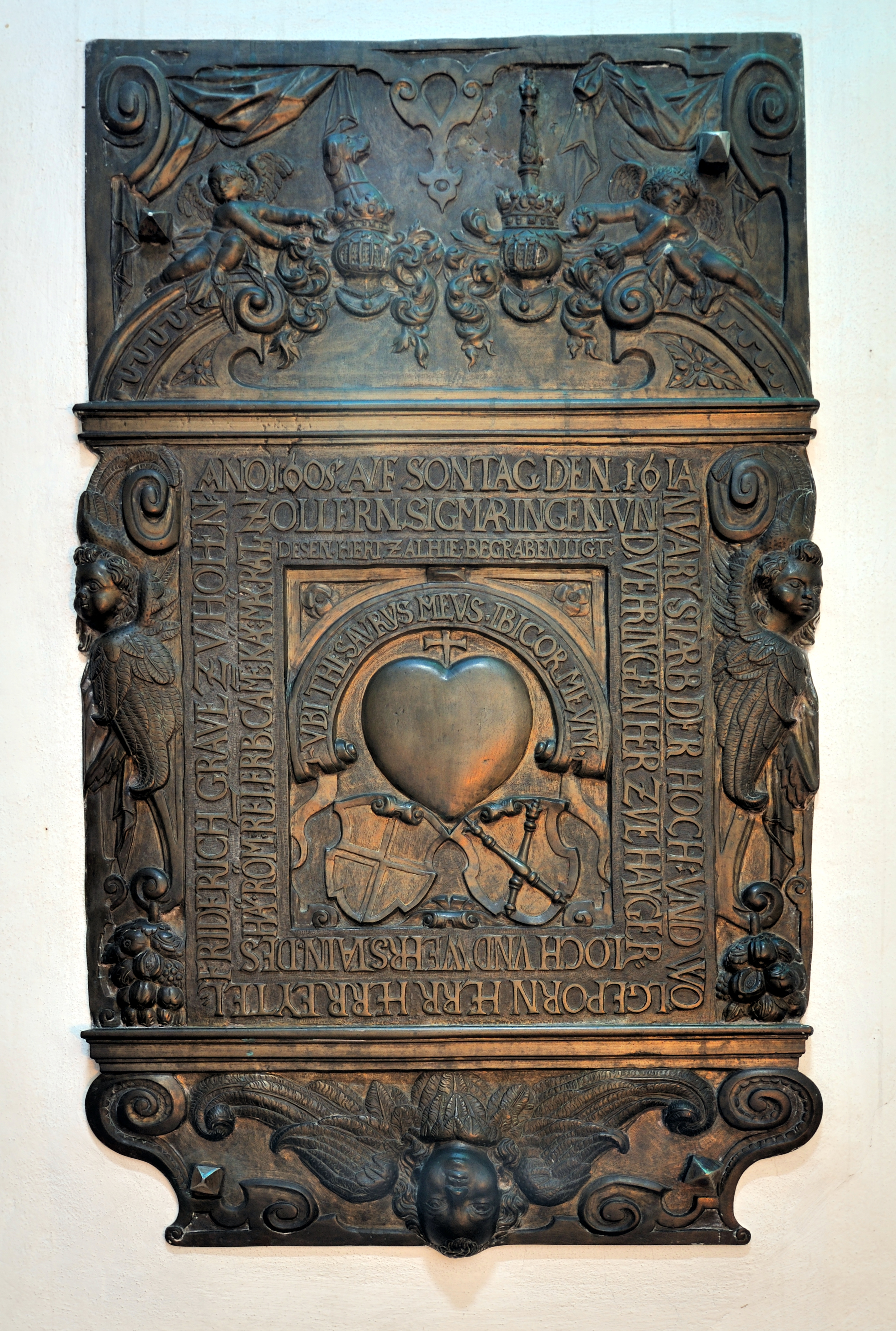|
Hohenzollern-Sigmaringen
Hohenzollern-Sigmaringen () was a principality in southwestern Germany. Its rulers belonged to the junior House of Hohenzollern#Swabian branch, Swabian branch of the House of Hohenzollern. The Swabian Hohenzollerns were elevated to princes in 1623. The small sovereign state with the capital city of Sigmaringen was Annexation, annexed to the Kingdom of Prussia in 1850 following the abdication of its sovereign in the wake of the revolutions of 1848, then became part of the newly created Province of Hohenzollern. History The junior Swabia, Swabian branch is less well known to history than the senior Burgraviate of Nuremberg#List of burgraves, Franconian line, the latter of which became Burgraviate of Nuremberg, Burgraves of Nuremberg and later ruled Margraviate of Brandenburg, Brandenburg and Prussia, and the German Empire. The County of Hohenzollern-Sigmaringen was created in 1576, upon the partition of the House of Hohenzollern#County of Zollern, County of Hohenzollern, a fief of ... [...More Info...] [...Related Items...] OR: [Wikipedia] [Google] [Baidu] |
House Of Hohenzollern
The House of Hohenzollern (, ; , ; ) is a formerly royal (and from 1871 to 1918, imperial) German dynasty whose members were variously princes, Prince-elector, electors, kings and emperors of Hohenzollern Castle, Hohenzollern, Margraviate of Brandenburg, Brandenburg, Prussia, the German Empire, and Kingdom of Romania, Romania. The family came from the area around the town of Hechingen in Swabia during the late 11th century and took their name from Hohenzollern Castle. The first ancestors of the Hohenzollerns were mentioned in 1061. The Hohenzollern family split into two branches, the Catholic Church, Catholic Swabian branch and the Protestantism, Protestant Burgraviate of Nuremberg#List of burgraves, Franconian branch,''Genealogisches Handbuch des Adels, Fürstliche Häuser'' XIX. "Haus Hohenzollern". C.A. Starke Verlag, 2011, pp. 30–33. . which ruled the Burgraviate of Nuremberg and later became the Brandenburg-Prussian branch. The Swabian branch ruled the principalities of Hoh ... [...More Info...] [...Related Items...] OR: [Wikipedia] [Google] [Baidu] |
Karl Anton, Prince Of Hohenzollern (died 1885)
Karl Anton, Prince of Hohenzollern-Sigmaringen (German: ; 7 September 1811 – 2 June 1885) was the last prince of Hohenzollern-Sigmaringen before the territory was annexed by the Kingdom of Prussia in 1849. Afterwards he continued to be titular prince of his house and, with the death of the last prince of Hohenzollern-Hechingen in 1869, of the entire House of Hohenzollern. He served as Minister President of Prussia from 1858 to 1862, the only Hohenzollern prince to hold the post. His second son, Karl, became king of Romania. The offer of the throne of Spain to his eldest son, Leopold, was one of the causes of the Franco-Prussian War, which led to the unification of Germany and the creation of the German Empire. Family and studies Karl Anton was born at Krauchenwies Castle in Sigmaringen, the second child of Karl, Prince of Hohenzollern-Sigmaringen (1785–1853) and the French princess Marie Antoinette Murat (1793–1847). Karl Anton studied law in Geneva, at the Universi ... [...More Info...] [...Related Items...] OR: [Wikipedia] [Google] [Baidu] |
Sigmaringen Castle
Sigmaringen Castle () was the princely castle and seat of government for the Princes of Hohenzollern-Sigmaringen. Situated in the Swabian ''Alb'' region of Baden-Württemberg, Germany, this castle dominates the skyline of the town of Sigmaringen. The castle was rebuilt following a fire in 1893, and only the towers of the earlier medieval fortress remain. Schloss Sigmaringen was a family estate of the Swabian Hohenzollern family, a cadet branch of the Hohenzollern family, from which the German Emperors and kings of Prussia came. During the closing months of World War II, Schloss Sigmaringen was briefly the seat of the Vichy French Government after France was liberated by the Allies. The castle and museums may be visited throughout the year, but only on guided tours. It is still owned by the Hohenzollern-Sigmaringen family, although they no longer reside there. Location Sigmaringen is located on the southern edge of the Swabian Jura, a plateau region in southern Baden-W� ... [...More Info...] [...Related Items...] OR: [Wikipedia] [Google] [Baidu] |
Johann, Prince Of Hohenzollern-Sigmaringen
Prince Johann of Hohenzollern-Sigmaringen (17 August 1578 in Sigmaringen – 22 March 1638 in Munich), was the ruling Count of Hohenzollern-Sigmaringen from 1606 to 1623. He was elevated to the rank of prince in 1623 and so was ''Prince'' of Hohenzollern-Sigmaringen from 1623 until his death. Life Johann was the eldest surviving son of Count Karl II of Hohenzollern-Sigmaringen (1547–1606), from his marriage to Euphrosyne (1552–1590), the daughter of Count Friedrich V of Oettingen-Wallerstein. He studied law and political sciences at the Universities of Freiburg and Ingolstadt. On 30 June 1602 in Sigmaringen, Johann married the three years younger Countess Johanna (1581–1634), the daughter of Count Eitel Friedrich IV of Hohenzollern-Hechingen. On 8 April 1606, his father died and Johann inherited the county. Unlike their relatives who ruled the Electorate of Brandenburg, the Sigmaringen branch of the House of Hohenzollern had remained Catholic. However, S ... [...More Info...] [...Related Items...] OR: [Wikipedia] [Google] [Baidu] |
Charles II, Count Of Hohenzollern-Sigmaringen
Charles II, Count of Hohenzollern-Sigmaringen (; 1547 – 8 April 1606) became Count of Hohenzollern-Sigmaringen in 1576 and remained so until his death. He was the fifth but second surviving son of Charles I, Count of Hohenzollern, and Anna, daughter of Ernest, Margrave of Baden-Durlach. Life Initially, he was educated in Vienna, and later in Freiburg im Breisgau jointly with his older brother Eitel Friedrich. Later, he assisted to the Aulic Council in Vienna, where his father served as president; there, he gained the trust and friendship of Ferdinand II, Archduke of Further Austria, (son of Holy Roman Emperor Ferdinand I) and went into his service to Tyrol, being able to established good connections with the Holy Roman Empire, which was seen in 1570 when he was appointed Supreme Captain and Governor in Alsace. Two years later, Charles II took over the guardianship of Count Jakob of Geroldseck. Under the rule of his father Charles I the possessions of the county of Zollern ... [...More Info...] [...Related Items...] OR: [Wikipedia] [Google] [Baidu] |
Sigmaringen
Sigmaringen ( Swabian: ''Semmerenga'') is a town in southern Germany, in the state of Baden-Württemberg. Situated on the upper Danube, it is the capital of the Sigmaringen district. Sigmaringen is renowned for its castle, Schloss Sigmaringen, which was the seat of the principality of Hohenzollern-Sigmaringen until 1850 and is still owned by the Hohenzollern family. Geography Surrounded by wooded hills Sigmaringen lies in the Danube valley, south of the Swabian Alps and around 40 km north of Lake Constance. The surrounding towns are Winterlingen (in the district of Zollernalb) and Veringenstadt in the north, Bingen, Sigmaringendorf, and Scheer in the east, Mengen, Krauchenwies, Inzigkofen, and Meßkirch in the south, and Leibertingen, Beuron, and Stetten am kalten Markt in the west. The town is made up of the following districts: Sigmaringen town center, Gutenstein, Jungnau, Laiz, Oberschmeien, and Unterschmeien. Climate Sigmaringen's climate is classified ... [...More Info...] [...Related Items...] OR: [Wikipedia] [Google] [Baidu] |
Christoph, Count Of Hohenzollern-Haigerloch
Count Christoph of Hohenzollern-Haigerloch (20 March 1552 in Haigerloch – 21 April 1592, Haigerloch) was the first Count of Hohenzollern-Haigerloch. Life Christoph was the third surviving son of Count Karl I of Hohenzollern (1516–1576) from his marriage to Anna (1512–1579), daughter of Ernst, Margrave of Baden-Durlach. Christoph studied law together with his brother Karl II (1547–1606) studied in Freiburg im Breisgau and Bourges. When Karl I died in 1576, the County of Hohenzollern was divided into Hohenzollern-Hechingen, Hohenzollern-Sigmaringen and Hohenzollern-Haigerloch. Christoph, the youngest son, received the Lordship of Haigerloch, which had been acquired in 1497. It included Enisheim Castle and the towns of Imnau and Stetten. His eldest brother Eitel Friedrich IV received Hechingen, his other brother Karl II received Sigmaringen. Christoph's part had 10000 inhabitants at the time and was substantially smaller than the parts of his brothers. Christ ... [...More Info...] [...Related Items...] OR: [Wikipedia] [Google] [Baidu] |
States Of The Confederation Of The Rhine
The Confederated States of the Rhine, simply known as the Confederation of the Rhine or Rhine Confederation, was a confederation of German client states established at the behest of Napoleon some months after he defeated Austrian Empire, Austria and Russian Empire, Russia at the Battle of Austerlitz. Its creation brought about the dissolution of the Holy Roman Empire shortly afterward. The Confederation of the Rhine lasted for only seven years, from 1806 to 1813, dissolving after Napoleon's defeat in the War of the Sixth Coalition.Hans A. Schmitt. "Germany Without Prussia: A Closer Look at the Confederation of the Rhine". ''German Studies Review'' 6, No. 4 (1983), pp 9–39. The founding members of the confederation were German princes of the Holy Roman Empire. They were later joined by 19 others, altogether ruling a total of over 15 million people. This granted a significant strategic advantage to the French Empire on its eastern frontier by providing a buffer between France and ... [...More Info...] [...Related Items...] OR: [Wikipedia] [Google] [Baidu] |
German Confederation
The German Confederation ( ) was an association of 39 predominantly German-speaking sovereign states in Central Europe. It was created by the Congress of Vienna in 1815 as a replacement of the former Holy Roman Empire, which had been dissolved in 1806 as a result of the Napoleonic Wars. The Confederation had only one organ, the '' Bundesversammlung'', or Federal Convention (also Federal Assembly or Confederate Diet). The Convention consisted of the representatives of the member states. The most important issues had to be decided on unanimously. The Convention was presided over by the representative of Austria. This was a formality, however, as the Confederation did not have a head of state, since it was not a state. The Confederation, on the one hand, was a strong alliance between its member states because federal law was superior to state law (the decisions of the Federal Convention were binding for the member states). Additionally, the Confederation had been established for ... [...More Info...] [...Related Items...] OR: [Wikipedia] [Google] [Baidu] |
Eitel Friedrich IV, Count Of Hohenzollern
Count Eitel Friedrich IV of Hohenzollern (7 September 1545 in Sigmaringen – 16 January 1605 in Hechingen) was the founder and first Count of the line Hohenzollern-Hechingen as Eitel Friedrich I. Early life Eitel Friedrich was the eldest surviving son of Count Karl I of Hohenzollern (1516–1576) from his marriage to Princess Anna of Baden-Durlach (1512–1579), daughter of the Margrave Ernst of Baden-Durlach. Biography After his father's death in 1576, Hohenzollern was divided. Eitel Friedrich became the founder of the Hohenzollern-Hechingen line; his brother Karl founded the Hohenzollern-Sigmaringen line, and his brother Christoph founded the Hohenzollern-Haigerloch line. Hohenzollern-Hechingen included the original County of Zollern, with the town of Hechingen and monasteries at Rangendingen, St. Luzen and Stetten. Eitel Friedrich reorganized the administration of the county, which his predecessors had neglected. He issued strict hunting and forestry regula ... [...More Info...] [...Related Items...] OR: [Wikipedia] [Google] [Baidu] |






